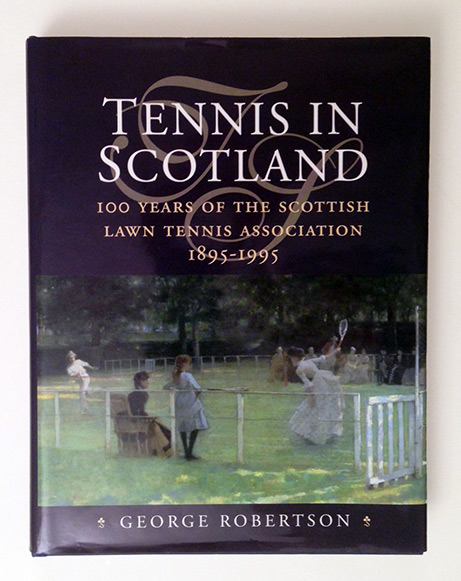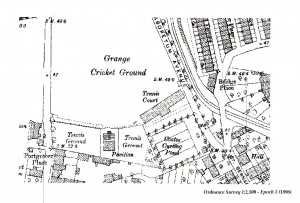The OS map from 1896 shows the original site of the Tin Temple, just north of the Coates Curling pond. The small gallery extension is shown to the south east, presumably with an entrance off the track shown to the south. Interestingly where the track meets the wall bordering Arboretum Avenue the gate piers for two entrances clearly remain.

George Robertson’s book ‘Tennis in Scotland’ provides great insight into the rich history of tennis at the Grange.
“So far as I have been able to ascertain lawn tennis, as we know it today, goes back to about 1874, when Major Walter Wingfield produced the new version of the game of tennis, including a new type of court.” (p.18)
“We know before 1874 tennis, or real tennis, or a variation of the game, was being played at various places in Scotland. For example, in the early 1870’s tennis, or real tennis, was played regularly in Grindlay Street Drill Hall in Edinburgh by a small group of players, mostly advocates. In 1874 one of their number, James Patten (later Sir James Patten MacDougal) decided to try the Wingfield verson of the game- then known as ‘sphairistike’ from the Greek for ‘skill with playing at ball’- outdoors at the Grange Cricket Field. Tennis, however, continued to be played indoors at Grindlay Street Drill Hall until that was replaced later in the decade by a building on the Grange Cricket Ground that became popularly known as the ‘Tin Temple’. It consisted of two courts, a dressing room and a small gallery, and stood on the east side of the Grange Pavilion in an area now occupied by three grass courts. This was the venue in 1878 for the first Scottish Championships, which were won by James Patten, the young advocate who started it all.” (p18)
Dyvours Lawn Tennis Club
“Dyvours is worthy of special mention because, although it was not the first club to be formed in Scotland, its roots go back to the very origins of the game itself. This is well and fully explained in the booklet by Phil Sked that was produced to mark the club’s centenary in 1983.”
“I referred earlier to the first hesitant steps of outdoor tennis in Scotland and to the building of the ‘Tin Temple’. As outdoor tennis had gradually been gaining popularity since that time, a small group of players from the ‘Tin Temple’ met in 1883 under the chairmanship of Graham Murray (later Lord Dunedin, who was to become the first Honorary President of the Association) and resolved to from themselves into a club. J.G. Horn, the first President of the Association, was a founder member of the club and was also probably at the meeting.”
“The choice of name is interesting and indicates the influence of the legal fraternity. ‘Dyvours’ is Scots for Bankruptcy, and those found to be so were required to wear ‘dyvours hose’- stockings of different colours. Lord Dunedin is quoted as saying he thought ‘it was an appropriate name as we had no grounds of our own and intended to play on other people’s grounds and eat other people’s lunches!’ In its early years there were in fact two clubs, a winter club, which played in the ‘Tin Temple’, and a summer club, which played on the adjoining outdoor courts, with an additional subscription giving dual membership. The ‘Tin Temple’ was demolished in 1902.”
“In its early years the club was undoubtedly at the heart of Scottish tennis and exerted a great influence on the development of the game and of the Association. Although its influence waned it has had to cope with many difficulties, it has survived, and still plays at the Grange, with five grass and three artificial grass courts and a membership in 1993 of 150 (124 seniors and 26 juniors)” (p22)


